|
Impact Windows
Suncoast recommends
Simonton and TRACO Impact Windows
Simonton
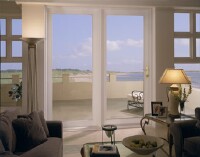 Do
you live in a home on the coast? Or, maybe you do construction work
on homes in a windy, coastal area? If so, you can now relax and
sleep a little easier. Do
you live in a home on the coast? Or, maybe you do construction work
on homes in a windy, coastal area? If so, you can now relax and
sleep a little easier.
Simonton Windows® has introduced
Simonton StormBreaker Plus™,
an impact resistant product line designed for high windborne coastal
areas. Double Hung Tilt, Casement, Awning, Geometric and Picture
style windows are all included in the new product line, plus an
impact resistant Garden Door (available with center hinge outswing).
Products in the Simonton
StormBreaker Plus line feature KeepSafe® Maximum glass.
The units are composed of a
piece of heavy polyvinyl butyral (PVB) plastic interlayer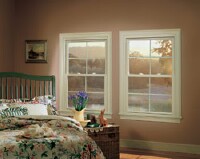 sandwiched between two pieces of double-strength glass. The
laminated glass is then combined with another piece of
double-strength tempered glass to form an insulating glass (IG)
unit. The IG unit, which has been sealed together to form a strong,
impact-resistant bond, is then glazed into the sash to hold the
glass in the frame. The glazing process from Simonton uses a
structural back bedding system to ensure the entire unit passes
impact tests and performs admirably in installed situations.
sandwiched between two pieces of double-strength glass. The
laminated glass is then combined with another piece of
double-strength tempered glass to form an insulating glass (IG)
unit. The IG unit, which has been sealed together to form a strong,
impact-resistant bond, is then glazed into the sash to hold the
glass in the frame. The glazing process from Simonton uses a
structural back bedding system to ensure the entire unit passes
impact tests and performs admirably in installed situations.
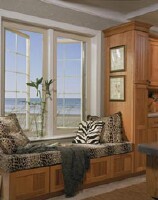 "Living
in a coastal areas with high winds can be a wonderful, yet sometimes
unsettling experience," says Bill Lazor, senior brand manager at
Simonton Windows. "Unexpected powerful storms can cause damage to
the home --- and windows are oftentimes most vulnerable. The new
Simonton StormBreaker Plus products can lessen concerns about the
exposure of the home to both storms and potential intruders. These
products have been proven to offer security and safety to the home." "Living
in a coastal areas with high winds can be a wonderful, yet sometimes
unsettling experience," says Bill Lazor, senior brand manager at
Simonton Windows. "Unexpected powerful storms can cause damage to
the home --- and windows are oftentimes most vulnerable. The new
Simonton StormBreaker Plus products can lessen concerns about the
exposure of the home to both storms and potential intruders. These
products have been proven to offer security and safety to the home."
Feel the strength of Simonton StormBreaker Plus products. When independently tested with air cannons, these windows didn’t just survive, they laughed in the face of the storm.
Think you’re hard on your windows? In the air cannon tests,
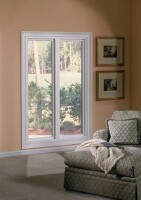 a two-by-four piece of lumber, nine-feet long, weighing nine pounds, was shot at specific and varying parts of the window unit at a rate of 50-feet per second. After the impacts, the units were then subjected to 9,000 cycles of combined positive and negative pressure. To pass the test, each unit subjected to these conditions needed to continue functioning. The glass had to stay intact in the sash and the Double Hung and Casement windows operationally. Strong and beautiful, Simonton StormBreaker Plus products are ideal for your coastal area home. a two-by-four piece of lumber, nine-feet long, weighing nine pounds, was shot at specific and varying parts of the window unit at a rate of 50-feet per second. After the impacts, the units were then subjected to 9,000 cycles of combined positive and negative pressure. To pass the test, each unit subjected to these conditions needed to continue functioning. The glass had to stay intact in the sash and the Double Hung and Casement windows operationally. Strong and beautiful, Simonton StormBreaker Plus products are ideal for your coastal area home.
The Simonton
Collection® includes a variety of product lines.
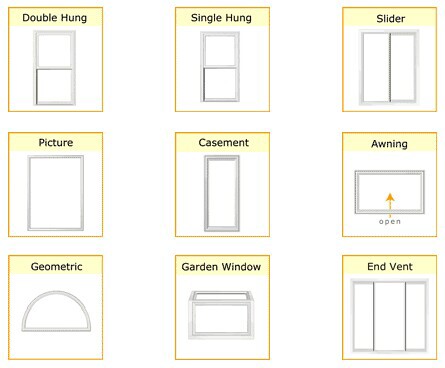
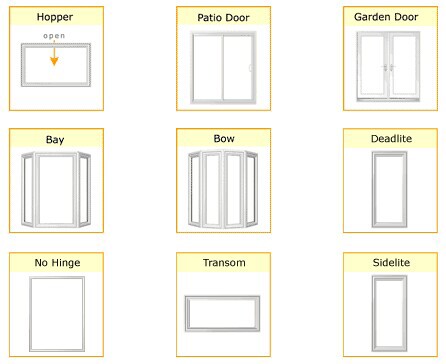
TRACO
TRACO Impact Resistant Window and Door Systems bring an expertise
and understanding of the unique needs of coastal area markets with
the right products, the right technology, and the right approach.
Specifically designed to meet strict building codes and the toughest
coastal weather challenges, TRACO Impact products are tested to
withstand the most severe hurricane force wind loads. High design
pressure windows and sliding-terrace doors goes beyond the
traditional benefits such energy-saving-performance by providing
added safety, security and peace-of-mind.
What is
impact glass?
Impact glass is a laminated glazing product, produced by bonding
a combination of plastic vinyl layers and polyester film between
two pains of glass into a single sheet. Laminated glass looks
like ordinary glass, but protects like a shield against
accidental impact, forced entry, sun damage and unwanted noise.
Tests show that specially designed laminated glass products pass
windborne debris impact tests, and when broken the glass
fragments tend to remain integral, adhering to the plastic
interlayer, helping to preserve the integrity of the building
envelope. Impact glass is provided in a Low-E configuration, but
it does not have an open space between the two glass panes.
What
does Low-E stand for and how does it benefit my project?
Low-E stands for low-emissivity, which is the power of a surface
to emit heat by radiation. This type of glass cuts the loss of
heat during the winter and cuts the absorption of heat during
the summer by reflecting the heat back to its source, thus
providing year-round savings by lowering utility bills. Low-E
glass also selectively filters the sun’s energy, blocking up to
84% of the sun’s ultraviolet rays in the summer, thereby
reducing the degree of fading of upholstery, carpet and drapes.
Low-E also reduces heating costs reflecting room side heat back
into the room with a resulting in a lower winter U-value.
What is
insulated glass?
Technically, there are two or more panes of glass separated by
insulation at the edges and air in the center to provide greater
thermal efficiency to a window.
What is
a gas-filled window?
Modern window technology permits an inert gas, usually argon, to
be sealed between the panes of glass in a window instead of air.
The gas is a far better insulator that just air, thus further
increasing the thermal value of a window.
What
are some common styles of windows on the market today?
Depending on region and personal style, single-hung, double
hung, casement, awning, slide-by, bay and bow windows are the
most frequently used. A number of other style windows are
frequently employed as accent windows.
How
does a double hung window differ from a single hung window?
A double-hung window has two vertically moving sashes, each
opening and closing a different part of the window. While a
single hung window has only one moving sash, which is the bottom
portion of the window.
What
is a casement window?
A casement window is a window unit hinged at the side that
swings outward, operated by a cranking mechanism.
What
is an awning window?
An awning window is hinged at the top and swings out at the
bottom to open, operated by a cranking mechanism.
What
is a bay window?
A bay window is a series of usually three windows assembled in a
polygon shape that projects outward from the side of a house.
How
does this differ from a bow window?
Bow windows are very similar to bays, in that they also project
from the side of a house. However, they are usually composed of
a series of five window units assembled in an arc, rather than a
polygon.
You
mentioned that a number of special units are also available for
use either separately or in conjunction with the units above.
What are some of these units?
Many of these are special shapes. For example, they include
hexagonal windows, round windows, half and quarter-rounds (which
are exactly what the name implies), dormer windows, French
windows (two casement sash hinged together to allow them to be
opened into a confined space), lancet windows (tall narrow
windows with a pointed arch top frequently used in Gothic
architecture), and transoms, which are window units usually
located above a door.
What
are mullions?
Mullions are vertical members between window units. They are
sometimes confused with muntins, which are secondary framing
members that hold multiple panes of glass in the sash. Other
parts of the sash include stiles (the outside vertical members)
and rails (the top and bottom horizontal members).
I
have heard windows referred to as lights, is this another type
of window?
Lights (sometimes also spelled lites) are individual panes of
glass within a window. Windows are usually designed/measured by
the number of “lights” it has in each sash.
What
are jambs?
Jambs are framing members used to support the window in the
wall. Those framing members on the side are, logically enough,
called side jambs. The framing member at the top is a head jamb.
There are no jambs at the bottom. This framing member is
referred to as a sill.
There are many general terms that I hear quite often, but some
of them I do not understand. For example, what is a sash?
A sash, simply put, is the entire window, including the glass
and the surrounding pieces that hold it together. The sash fits
into a frame that is actually tied into the surrounding wall and
holds the sash in place.
Why do my new
insulated-glass windows "sweat" during cold weather?
Even the best-insulated
windows can condense moisture from the air if the outdoor
temperature is low enough and the indoor relative humidity is
high enough. You're probably using a room humidifier or a
humidification system connected with your furnace. Assuming that
the windows were properly installed, try reducing the humidity
setting during very cold weather.
Here are a few tips on
reducing the moist air in your home:
- Use fans in
bathrooms, kitchens and laundry rooms to circulate the air.
- Air out your home frequently by
opening doors and windows.
- Reduce the number of indoor
house plants, as plants increase humidity levels.
- Use a dehumidifier to remove
excess humidity from the air.
General Information
Configurations
-
Double
weather-stripping throughout.
-
Full
view or colonial muntins.
-
Forced-entry approved and burglar resistant.
-
All
stainless steel hinges. Heavy-duty operators and locks.
Materials
-
All
frames, vents and screen frames are manufactured of extruded
6063-T6 aluminum.
-
Frames
and vents are constructed using stainless steel corner keys.
-
Single
row plastic backed and shrink resistant. Applied to both frame
and vent.
-
Non
impact units are available with 3/16" and 1/4" thick glass
annealed or tempered.
-
Insulated units have 1/2" overall glass thickness.
-
Impact
resistant units use .125/.090/.125 annealed or heat treated
glass.
-
All
hardware is manufactured by Truth Hardware or equal, and come
with a 5 year limited warranty.
-
All
aluminum members will received an ESP finish.
-
Available with impact resistant glass, insulated glass, tempered
safety glass.
-
Standard colors are white, tan, bronze ESP and clear anodized,
custom colors available.
Performance
-
Design
pressure of positive and negative 85 psf (unit test size 48” x
120”)
-
No
water penetration at 15 psf of positive pressure
-
Air
infiltration = 0.050 cfm/sq. Ft. at a pressure differential of
6.24 psf
-
Tested
and passed Dade County Pa 201, 202, 203.
-
Original Dade County Acceptance No. 96-1024.02
-
Renewal Dade County acceptance No. 00-0524.003
Materials
-
ALUMINUM: 6063-t6 extruded aluminum frame members and 6063-t5
aluminum glazing beads. Minimum wall thickness for main framing
members to be .090 thickness and glazing beads .070 thickness
-
GLASS:
Uvekol glazing panel consisting of, outboard light of ¼” thick
glass with an interlayer .120 mil laminate and inboard light of
¼” thick glass.
Impact and
Cyclic Test Standards
|
SBCCI
SSTD 12
LARGE MISSILE IMPACT TEST:
Height and grade up to and including 30.0 feet.
-
Impact Option 1: Three
identical test specimens, each specimen is impacted
twice. One at the center and one within 6" (152mm)
of a corner.
-
Impact Option 2: Six test
specimens, each impacted once. Three specimens at
center, three specimens impacted within 6" (152 mm)
of a corner.
-
Options 1 and 2
consists of a 2" x 4" Timber.
-
Weight and speed of the 2" x 4" Timber specific
to wind speed:
90 < wind speed = 100 4lb. (2kg) missile
impacting at a speed of 40 ft. (12m)/sec
|
100 < wind speed = 1108 4lb. (4kg) missile
impacting at a speed of 40 ft. (12m)/sec
|
Wind speed = 110 9 lb. (4kg) missile
impacting at a speed of 50 ft. (12m)/sec
|
-
Impact Option 3-pendulum impact
apparatus. Refer to test standard for impact
criteria.
-
To past test no penetration is allowed in which
a 3" (76 mm) diameter sphere can pass. (Impact
Options 1-3)
-
The cyclic pressure loading test is not required
when at one ply of the impact glass product does not
beak during missile impact test and the material is
designed to withstand the design wind pressure. (Impact
Options 1-3)
|
|
SMALL MISSILE IMPACT TEST:
Height above 30 feet (9m).
-
Three identical test specimens.
-
Test is conducted with steel balls each weighing
2 grams and impacting at a speed between 130 ft. per
sec. and 132 ft. per sec.
-
Test consist of thirty small missile impacts:
110 at the center, 10 at the center/long dimension
side, 10 at the corner
-
The specimen passes the impact test if/when no
penetrations are created in which a 3" (76 mm)
diameter sphere can pass through.
-
All three specimens must pass prior to
proceeding to the cyclical pressure loading test.
NOTE:
The cyclic pressure loading test is not required
when at least one ply of the impacted glass make-up
does not fracture during missile impact test and the
ply is designed to withstand the design wind
pressure.
|
|
CYCLIC WIND PRESSURE LOADING
SFBC and SBCCI
Test specimens passing the large and small missile impact
test criteria move on to the cyclic wind pressure test.
Pmax: Denotes the maximum design load
allowed in accordance with ASCE 7-88. "Minimum Design Loads
for Buildings and Other Structures."
Pass/Fail Criteria
SFBC - Dade County Addition: A particular
system of construction shall be deemed to comply with this
recommended practice if three test specimens reject the
missile impacts without penetration and resist the cyclic
pressure loading with no cracks forming which are longer
than 5" and 1/16" wide through which air can pass.
SBCCI SSTD 12: The test specimens shall
resist the missile impacts prescribed and resist the
cyclical pressure loading with no cracks forming longer that
5" through which air can pass or with no opening through
which a 3" diameter sphere can pass. |
|

 Do
you live in a home on the coast? Or, maybe you do construction work
on homes in a windy, coastal area? If so, you can now relax and
sleep a little easier.
Do
you live in a home on the coast? Or, maybe you do construction work
on homes in a windy, coastal area? If so, you can now relax and
sleep a little easier.  sandwiched between two pieces of double-strength glass. The
laminated glass is then combined with another piece of
double-strength tempered glass to form an insulating glass (IG)
unit. The IG unit, which has been sealed together to form a strong,
impact-resistant bond, is then glazed into the sash to hold the
glass in the frame. The glazing process from Simonton uses a
structural back bedding system to ensure the entire unit passes
impact tests and performs admirably in installed situations.
sandwiched between two pieces of double-strength glass. The
laminated glass is then combined with another piece of
double-strength tempered glass to form an insulating glass (IG)
unit. The IG unit, which has been sealed together to form a strong,
impact-resistant bond, is then glazed into the sash to hold the
glass in the frame. The glazing process from Simonton uses a
structural back bedding system to ensure the entire unit passes
impact tests and performs admirably in installed situations.
 "Living
in a coastal areas with high winds can be a wonderful, yet sometimes
unsettling experience," says Bill Lazor, senior brand manager at
Simonton Windows. "Unexpected powerful storms can cause damage to
the home --- and windows are oftentimes most vulnerable. The new
Simonton StormBreaker Plus products can lessen concerns about the
exposure of the home to both storms and potential intruders. These
products have been proven to offer security and safety to the home."
"Living
in a coastal areas with high winds can be a wonderful, yet sometimes
unsettling experience," says Bill Lazor, senior brand manager at
Simonton Windows. "Unexpected powerful storms can cause damage to
the home --- and windows are oftentimes most vulnerable. The new
Simonton StormBreaker Plus products can lessen concerns about the
exposure of the home to both storms and potential intruders. These
products have been proven to offer security and safety to the home." a two-by-four piece of lumber, nine-feet long, weighing nine pounds, was shot at specific and varying parts of the window unit at a rate of 50-feet per second. After the impacts, the units were then subjected to 9,000 cycles of combined positive and negative pressure. To pass the test, each unit subjected to these conditions needed to continue functioning. The glass had to stay intact in the sash and the Double Hung and Casement windows operationally. Strong and beautiful, Simonton StormBreaker Plus products are ideal for your coastal area home.
a two-by-four piece of lumber, nine-feet long, weighing nine pounds, was shot at specific and varying parts of the window unit at a rate of 50-feet per second. After the impacts, the units were then subjected to 9,000 cycles of combined positive and negative pressure. To pass the test, each unit subjected to these conditions needed to continue functioning. The glass had to stay intact in the sash and the Double Hung and Casement windows operationally. Strong and beautiful, Simonton StormBreaker Plus products are ideal for your coastal area home.
